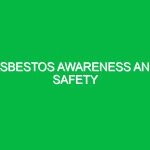In the realm of Health, Safety, and Environment (HSE), lead safety in the workplace stands as a critical concern that demands attention. Lead is a toxic metal that can have severe health implications for workers exposed to it. As industries evolve, so too do the practices and regulations surrounding lead safety, making it imperative for employers and employees alike to remain informed and vigilant. This article delves into the significance of lead safety, the hazards associated with lead exposure, and actionable safety precautions to mitigate risks in the workplace.
Understanding Lead Safety in the Workplace
Lead safety in the workplace refers to the measures and protocols implemented to protect employees from the harmful effects of lead exposure. Lead is commonly found in various industries, including construction, manufacturing, and painting. Its properties make it useful for many applications, yet its toxic nature poses significant health risks. Understanding the implications of lead exposure is essential for fostering a safe working environment.
Why is Lead Safety Important?
The relevance of lead safety in the workplace cannot be overstated. Lead exposure can lead to a myriad of health issues, ranging from acute conditions such as lead poisoning to chronic effects, including neurological damage, reproductive problems, and developmental delays in children. According to the Centers for Disease Control and Prevention (CDC), even low levels of lead in the blood can be harmful, making it crucial for workplaces to adopt stringent safety measures.
Identifying Hazards and Risks Associated with Lead Exposure
Before implementing safety measures, it is vital to identify potential hazards associated with lead exposure in the workplace. These hazards can arise from various processes and environments:
1. Occupational Sources of Lead Exposure
Lead can enter the workplace through several avenues, including:
- Lead-based paints: Common in older buildings, the deterioration of lead paint can release toxic dust and chips.
- Construction and renovation work: Activities such as sanding and demolition can disturb lead-containing materials.
- Manufacturing processes: Industries such as battery manufacturing, metal smelting, and glass production often involve lead.
- Welding and soldering: Lead-containing solders and flux can release lead fumes when heated.
2. Routes of Lead Exposure
Understanding how lead can enter the body is crucial for effective prevention. The primary routes of exposure include:
- Inhalation: Breathing in lead dust or fumes is the most common route of exposure in industrial settings.
- Ingestion: Lead particles can contaminate food, beverages, and hands, leading to accidental ingestion.
- Dermal contact: Skin contact with lead dust or contaminated surfaces can also pose risks.
3. Vulnerable Populations
Certain groups are more susceptible to lead exposure. Pregnant women, children, and individuals with pre-existing health conditions can experience more severe health effects. For example, lead exposure in pregnant women can affect fetal development, leading to lifelong consequences for the child.
Safety Precautions and Best Practices for Lead Safety
To mitigate the risks associated with lead exposure, employers must implement a comprehensive lead safety program. Here are key safety precautions and best practices:
1. Conduct Regular Risk Assessments
Employers should conduct thorough risk assessments to identify potential lead hazards in the workplace. This includes evaluating work processes, materials used, and potential exposure scenarios. Regular audits can help ensure that the workplace remains compliant with safety standards.
2. Implement Engineering Controls
Engineering controls are essential in minimizing lead exposure. These may include:
- Ventilation systems: Installing local exhaust ventilation can help capture and remove lead dust and fumes from the air.
- Enclosure: Enclosing lead processes can prevent the spread of lead contamination into the surrounding environment.
- Wet methods: Utilizing wet sanding or spraying techniques can reduce airborne lead particles.
3. Provide Personal Protective Equipment (PPE)
Personal protective equipment plays a vital role in safeguarding workers from lead exposure. Employers should provide appropriate PPE, which may include:
- Respirators: Properly fitted respirators can protect against inhalation of lead dust and fumes.
- Protective clothing: Disposable coveralls can prevent lead dust from contaminating personal clothing.
- Gloves: Chemical-resistant gloves are essential to prevent skin contact with lead.
4. Implement Work Practices and Training
Developing safe work practices is critical for lead safety. Employees should be trained on the proper handling of lead materials, use of PPE, and hygiene practices, such as:
- Regular hand washing: Workers should wash their hands before eating or drinking to prevent ingestion of lead.
- Cleaning protocols: Establishing regular cleaning schedules using HEPA vacuums can help minimize lead dust.
- Signage: Clearly marking areas where lead exposure may occur can remind workers to take precautions.
5. Monitor Lead Exposure
Regular monitoring of lead levels in the workplace is essential. Employers should conduct air sampling and biological monitoring to assess exposure levels among employees. If lead levels exceed permissible limits, immediate action should be taken to reduce exposure and protect worker health.
Regulations and Standards Governing Lead Safety in the Workplace
In many countries, regulations govern lead safety in the workplace to ensure protection for employees. Some key regulations include:
- Occupational Safety and Health Administration (OSHA) Standards: In the United States, OSHA has established permissible exposure limits (PEL) for lead in the workplace. The PEL for lead is 50 micrograms per cubic meter of air over an 8-hour workday.
- National Institute for Occupational Safety and Health (NIOSH) Recommendations: NIOSH recommends exposure limits and monitoring guidelines to protect workers from lead hazards.
- Environmental Protection Agency (EPA) Regulations: The EPA regulates lead in various settings, including residential areas, to reduce environmental lead contamination.
Conclusion: A Commitment to Lead Safety
Lead safety in the workplace is a shared responsibility that requires commitment from both employers and employees. By understanding the hazards associated with lead exposure, implementing best practices, and adhering to regulatory standards, workplaces can significantly reduce the risks of lead exposure. The health and well-being of workers depend on proactive measures and continuous education regarding lead safety. Ultimately, fostering a culture of safety not only protects employees but also promotes productivity and enhances the overall workplace environment.
As we navigate the complexities of lead safety, remember that knowledge is power. By staying informed and vigilant, we can create safer workplaces for everyone.


